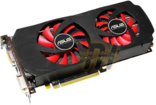Tuesday, April 14th 2009

ASUS High-End EAH4890 Cooler Pictures and Details Emerge
Towards the end of March, we caught a glimpse of a yet to be named high-end custom-designed Radeon HD 4890 accelerator from ASUS. The accelerator makes use of an exotic VRM design to facilitate high clock speeds and overclocking potential. Back then, we couldn't get pictures of what cooled the beast. Thankfully, NordicHardware has a few pictures of the cooler, along with more details in place.The cooler is a complex piece of engineering. It consists of a central copper GPU contact base from which six 230 mm long copper heatpipes distribute heat between the GPU and VRM areas, which have large heatsinks of their own. Two fans of dissimilar sizes are suspended on the shroud. The larger one, over the GPU, rotates clockwise, while the other counterclockwise. Looking at ASUS' design methods with high-end cards, we can safely guess the fans are controlled by a complex controller that adjusts fan speeds on a per-fan basis, depending on the temperatures of the various zones of this card.
From what the source tells, this cooler should run the card at least 10 °C cooler than what the reference cooler manages. This may facilitate stock clock speeds in excess of 900 MHz for the core, and 1000 MHz for the memory. Some credit of the electrical stability of the core at those speeds goes to the use of the Fujitsu-made SuperML capacitor, that reduces voltage noise by as much as 20% (from 143mV to 114mV). Regarding the exact brand name of this card, we can confirm that the card will not carry the "MATRIX" branding. The other high-end term ASUS uses, "TOP", has already been used for a factory-overclocked reference design accelerator, leaving the brand name yet to be disclosed.
Source:
NordicHardware
From what the source tells, this cooler should run the card at least 10 °C cooler than what the reference cooler manages. This may facilitate stock clock speeds in excess of 900 MHz for the core, and 1000 MHz for the memory. Some credit of the electrical stability of the core at those speeds goes to the use of the Fujitsu-made SuperML capacitor, that reduces voltage noise by as much as 20% (from 143mV to 114mV). Regarding the exact brand name of this card, we can confirm that the card will not carry the "MATRIX" branding. The other high-end term ASUS uses, "TOP", has already been used for a factory-overclocked reference design accelerator, leaving the brand name yet to be disclosed.

27 Comments on ASUS High-End EAH4890 Cooler Pictures and Details Emerge
I see no difference to reference card on either front- or backside other than the Fujitsu cap and 6+8pin instead of 6+6pin.Huh?
:confused: